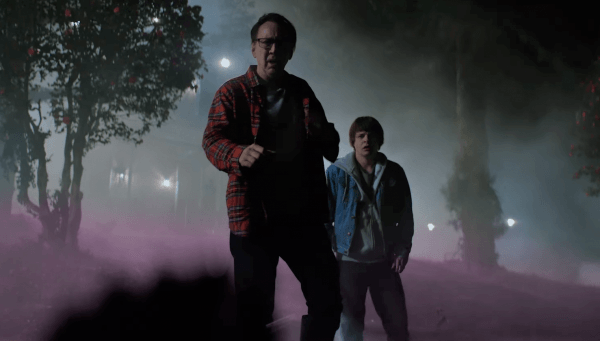Color Out of Space, 2020.
Directed by Richard Stanley.
Starring Nicolas Cage, Joely Richardson, Madeleine Arthur, Tommy Chong, Julian Hilliard, Elliot Knight, and Brendan Meyer.
SYNOPSIS:
A town is struck by a meteorite and the fallout is catastrophic.
What Richard Stanley’s Color Out Of Space best understands about Lovecraftian adaptations is an intentionally inexplicable source of manifested dread. H.P.’s short story was structured to be something “truly alien,” and is praised for its “vagueness” when describing the narrative’s otherworldly horrors. Stanley’s approach is, for better and worse, equally nebulous as Americana staples are engulfed by an enigma Crayola would probably designate “Tickle My Pineal Gland Pink.” Its candy-shelled cosmic horror with essences from The Thing, Society, Annihilation, and hard sci-fi lore meant to make us feel minuscule in the universe’s grand scheme. A story spoken through stoner parables, be warned.
In the town of Arkham, Nathan Gardner (Nicolas Cage) and his family live on an alpaca farm far from the busiest city landscapes. One night, a glowing meteorite crash lands in their yard and emits an illuminating blast of magenta waves. The littlest Gardner, Jack (Julian Hilliard), starts acting oddly after the incident – mannerisms that spread throughout the family. Theresa (Joely Richardson) tries to calm her husband’s mood swings, while siblings Lavinia (Madeleine Arthur) and Ben (Brendan Meyer) fear the asteroid has brought ruination to their doorstep.
The landscape Stanley promotes is one that’s sensuous and inviting from early introductions straight through the film’s ensuing “takeover,” farther than pinkish energies swirling in the form of auras. Our first meet-up with Lavinia is as she’s practicing Alexandrian dark arts, then rides away on a white steed like something from a pre-teen Salem fairytale. As Nathan strolls through his overgrowing garden and plucks novelty-sized tomatoes off vines, brightness floods Stanley’s vivid ecosystem. Even as bodies become slimy, amorphous amalgamations of their former selves or bloody remains taint these effervescent neon hues.
Mania is what propels Color Out Of Space. From hallucinogenic experiences throughout family members to an outsider’s paranoid perspective (hydrologist Ward, played by Elliot Knight) who refuses to drink liquids now tinged with “the color.” You don’t cast Nicolas Cage to only play “Superdad,” which becomes evident when Nathan “slam dunks” monster vegetation into his trash bin while his frustrated wife complains about losing clients to a wonky internet connection. Ever the unhinged maestro, Cage leads a larger movement as personalities wobble off their axis. Wildlife, foliage, and any other pigments now overtaken by the titular cotton-candy-calming coverall.
Themes of “perfect families” and “having it all” implode as characters lament over what they’ve abandoned in order to appease others. Everyone keeps drinking from their poisoned water supply while basking in the consequences of their actions, which somehow normalizes astonishing absurdity that withstands Stanley’s plunge into Lovecraft’s maddest influential reaches. The more humanity is lost, the more we’re drawn like Cthulu to chants from its worshippers. A clever trick since what we witness is never a battle between “good” and “evil,” just nature taking its course.
As the film unravels, Stanley’s dedication to visual storytelling becomes an overtaking factor. From Tommy Chong speaking in riddles to Theresa’s illness not even being referenced on a need to know basis, Stanley’s grasp on throughlines becomes laxer by the second. Those hoping for meaning will need to look exceedingly hard, down to details like Nathan’s instructional alpaca milking and Jack’s translation of alien voices. Color Out Of Space happens with or without you, like being swept away in Ghostbusters II’s river of slime no matter how hard you fight the current. Appreciation relies on an audience’s ability to value body horror effects and concentrated Lovecraftian wildness that plays mostly to optical highs.
It’s an ambitious adaptation, and one that admittedly works in ways I wasn’t positive Stanley could achieve. We’re never hammered into submission by Cage’s more extravagant performative qualities, despite his vocal pattern changing from “Hallmark Channel Family Man” to something more Deadfall reminiscent. Lovecraft’s usage of creatures is something Stanley honors, worth the film’s horror counterbalance to more enchanting sci-fi production values. As the woods come alive and bolts of lightning strike the glowing rock planted deep into crater soil, Stanley keeps a sense of necessary wonder intact – even when fangs are flashed to assure no such safety.
In the end, Color Out of Space explodes off the screen with luscious vitality like every trailer and marketing image ensures. It’s a film that wants to make you think about the mysteries that lurk under layers of predated history, buried seven times over and trampled underfoot without nary a thought. You’re here for the loudest shades of melancholy, unexpected interstellar anomalies, and Nicolas Cage’s disturbed patriarch with a shotgun à la Jack Torrance. Tommy Chong’s prophetic shaman squatter and Lavinia’s starter-kit witch training. Don’t go in expecting Mandy as some have expressed online hopes, but do go in ready to give yourself to “The Pinkening.”
Flickering Myth Rating – Film: ★ ★ ★ ★ / Movie: ★ ★ ★
Matt spends his after-work hours posting nonsense on the internet instead of sleeping like a normal human. He seems like a pretty cool guy, but don’t feed him after midnight just to be safe (beers are allowed/encouraged). Follow him on Twitter/Instagram/Letterboxd (@DoNatoBomb).















